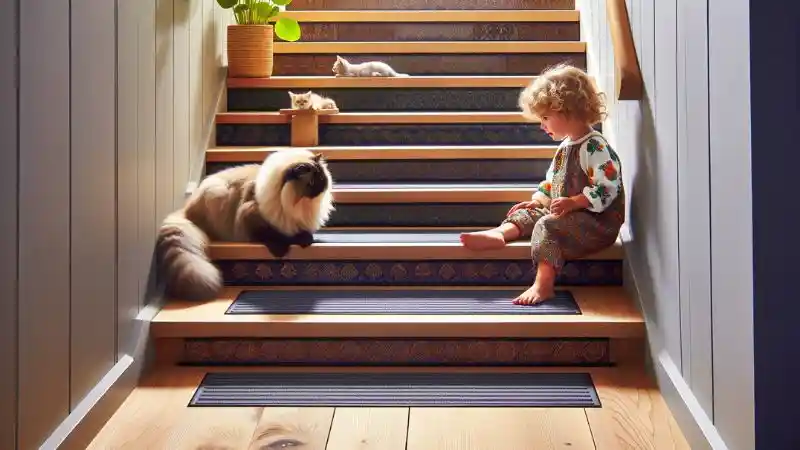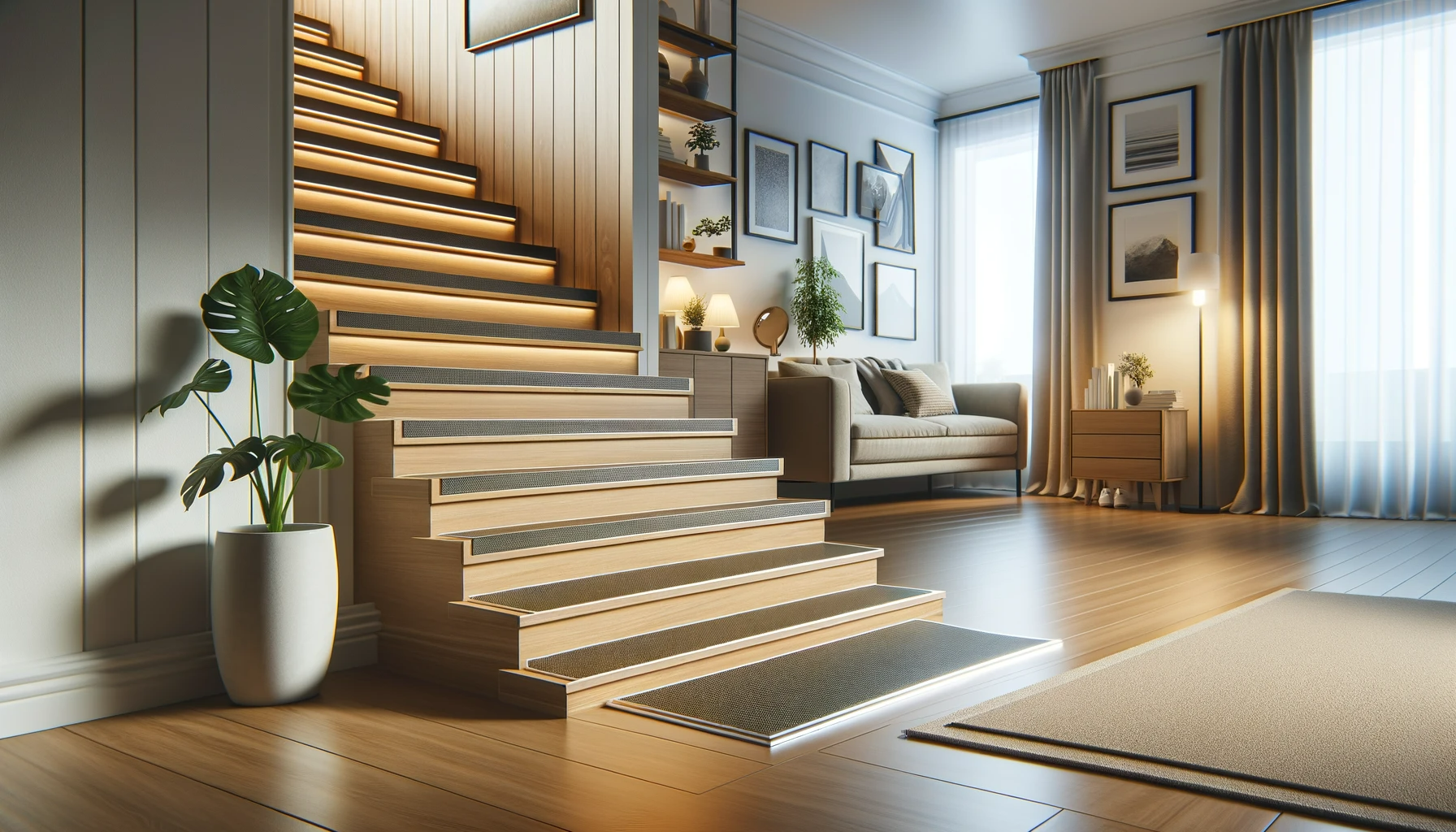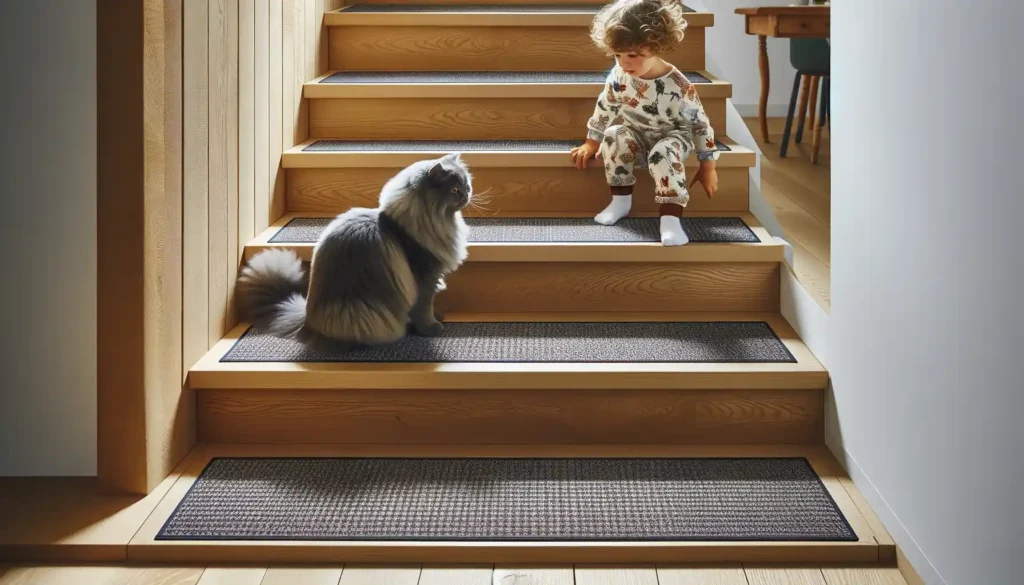Indoor Non Slip Stair Treads for Wood: Ultimate Safety Solution Guide
Indoor Non Slip Stair Treads are safety features installed on wooden stairs to prevent accidents. These innovative solutions enhance traction, minimizing the risk of slips and falls.
Perfect for homes with kids, elderly residents, or pets, Indoor Non slip stair treads for wood play an integral part in maintaining safety. They not only provide a grip to wooden staircases but also enhance their aesthetic appeal.
Made from durable, high-quality materials, these treads can withstand high foot traffic and extensive use. By using these stair treads, homeowners can significantly decrease the chances of stair-related accidents and mishaps.
Easy to install and available in various styles, these safety additions effortlessly merge with any home decor. Besides enhancing safety, they also protect the surface of wooden stairs, extending their lifespan.
The Slippery Predicament: Stairs As Safety Hazards
The Slippery Predicament: Stairs as Safety Hazards – Stairs, particularly wooden, pose a major fall risk. Accidents often happen when least expected. That’s when indoor non-slip stair treads for wood come into play.
Assessing Risks In Home And Office
At home or at work, stairs present dangers. A quick slip may lead to serious injuries. Employers and homeowners must assess these risks. These include considerations of:
- Tread design: Smooth, sleek treads are media for easy slips.
- Lighting: Poorly lit stairs make it hard to see steps clearly.
- Handrails: Lack of firm handholds make falls more likely.
Wooden Stairs: Elegance Meets Danger
Wood stairs add charm to home or office. Yet, they often lack grip, proving hazardous. Non-slip stair treads for wood solve this problem. They offer benefits like:
- Safety: They provide a gripping surface on slick wood.
- Preservation: They help protect wood from wear and tear.
- Easy installation: Most treads can be easily attached to stairs.
Stay safe by being aware of stair hazards. Then, mitigate risks with non-slip treads for wooden stairs. Up the safety without losing the elegance.
Materials Matter: Non Slip Tread Options

Slips and falls on indoor stairs can be hazardous. To prevent this, quality Indoor Non Slip Stair Treads for Wood are essential. Three primary materials predominate stair tread production: Rubber, Carpet and Vinyl.
Comparing Rubber, Carpet, And Vinyl Treads
The choice of material can greatly influence safety, aesthetics, and longevity of the treads. Below are details of each with their pros and cons:
| Material | Pros | Cons |
|---|---|---|
| Rubber | Durable, cost-effective, easy to clean | Less stylish |
| Carpet | Soft, cozy, offers many designs | Can wear out faster, harder to clean |
| Vinyl | Water-resistant, stain-resistant, inexpensive | Can become slippery when wet |
The Durability And Aesthetics Of Different Fabrics
The durability and look of stair treads depend on the material’s quality. Here’s a quick look at how each one fares:
- Rubber – Heavy-duty rubber can last for years. Yet, its industrial look may not fit all decors.
- Carpet – It provides warmth and coziness. But, high traffic can cause wear and tear.
- Vinyl – It’s low cost and easy to maintain. Yet, it may lose its appeal over time due to discoloration.
Final note: The decision of material depends on one’s needs, taste and budget. Choose wisely to ensure safety and style.
Installation Intricacies: Securing Treads
Safe stairs start with non-slip treads. They’re especially vital on wooden stairs. Indoor non slip stair treads for wood are straightforward but can have some complexities. We’ll explore them today. Here is the step-by-step guide to installing and securing treads, along with options for adhesives and non-permanent solutions.
Step-by-step Guide To Fitting Treads
Follow these steps for firm, safe treads. Remember to have your supplies and tools ready. Let’s begin.
- Measuring the Steps: Use a tape measure to know each step’s size.
- Marking the Steps: Mark where to place the treads. It’s best to center them.
- Preparing Treads: Trim treads to match step size. Ensure no fringes.
- Applying Adhesive: Apply adhesive on the back. This helps the tread stick firmer.
- Fitting the Treads: Begin from top. Firmly press treads onto steps.
Adhesives And Non-permanent Solutions
There is a variety of adhesive options. The same goes for removable measures. Treads can become worn out, or you may wish to change them. Here are some effective options:
- Contact Adhesive:
- This option ensures strong grip. It’s easy to apply with a brush or roller.
- Double-Sided Carpet Tape:
- A handy option. It’s quick and lets you adjust the tread position.
- Adhesive-free Treads:
- These treads cling onto stairs. They’re easy to remove and reposition.
Attention: Always check compatibility with your stairs

Credit: www.tindustrials.co.uk
Maintenance Musts: Keeping Treads Effective
Indoor non-slip stair treads for wood optimize safety measures at home or in the office. Prolong their life and effectiveness by paying attention to vital maintenance steps. Let’s delve into these key areas for tread care, namely cleaning techniques and routine inspections.
Cleaning Techniques For Longevity
Proper cleanliness of indoor non-slip stair treads for wood extends their lifespan. Ensuring a long-lasting effect begins with the correct cleaning procedure.
Follow these easy steps:
- Sweep off dust and crumbs using a soft broom.
- Combine mild soap and warm water in a bowl for a simple, harmless cleaning solution.
- Use a soft cloth to dip into the mixture. Wipe the treads gently.
- Rinse with clean water and make sure no soap remains on the treads.
- Dry properly to clear all moisture, which could damage the treads.
Routine Checks And Replacement
Regular inspections of the treads are vital. Start by checking for any visible wear or tear. Next, assess their slip-resistance. Is it still firm and efficient?
Replace any worn or less effective treads promptly. This keeps the stairs safe for everyone.
Consider the following points when checking the treads:
- Surface condition: Look out for any visible damage such as cracks or splits.
- Slip resistance: Check if the tread still provides a strong grip.
- Security: Be sure the tread is fully attached to the stair. A loose tread is a hazard.
- Replacement: If any tread looks worn out or doesn’t perform well, replace it immediately.
Legal And Compliance Concerns

When dealing with indoor non-slip stair treads for wood, attention to legal and compliance matters is essential. This includes meeting building codes and safety standards, and understanding liability around home safety. Let’s delve into these key areas:
Building Codes And Safety Standards
Stair treads play a part in fall prevention. Thus, they must align with building codes and safety standards.
-
Building regulations state that indoor stairs should have a non-slip surface. This is to prevent slipping, even when wet.
-
For safety, stair treads should cover the full width of the stair. No part of the stair should be left unshielded.
Not meeting these codes can result in legal challenges. Be sure to use treads compliant with your local codes.
Liability And Ensuring Home Safety
As a home owner, you have a duty to ensure your home is safe. This includes making stairs risk-free with non-slip stair treads.
-
Should anyone fall on your stairs, you could be held liable, especially if you did not have compliant treads.
-
Protect yourself and others by fitting treads that adhere to safety standards.
This is your home; your people. Keep them secure with the right non-slip stair treads.
Frequently Asked Questions On Indoor Non Slip Stair Treads For Wood
What Can You Put On Wood Stairs To Make Them Less Slippery?
Apply anti-slip adhesive tape to wooden stairs for quick solutions. Carpets or stair treads also provide extra grip. Alternatively, use a clear non-slip wood coating for preserving aesthetics. Regular cleaning can prevent dust accumulation, reducing slipperiness. Adopt these tips to enhance your stair safety.
How Do You Make Wooden Stairs Slip Proof?
Apply anti-slip tape or stair treads to increase friction. Add slip-resistant paint or a clear, textured slip-resistant coating. Install carpet runners for added grip. Regularly clean stairs to remove debris. Sand the steps if they’re overly smooth.
What Stair Treads Won’t Damage Wood?
Non-slip, adhesive-free stair treads protect wood without damage. Opt for rubber, silicone, or carpet with a gentle grip backing. Ensure treads are removable and leave no residue to preserve your wooden stairs.
What Is Non-slip Material For Wooden Stairs?
Non-slip material for wooden stairs includes gripper tape, anti-slip paint, rubber stair treads, or carpet mats. All these provide extra grip for footsteps, promoting safer navigation and reducing accident risks. They’re easy to install and blend well with different stair aesthetics.
Conclusion
Securing your home with indoor non-slip stair treads is a smart move. It merges safety with style, particularly for wooden staircases. Embarking on this simple upgrade can prevent mishaps and prolong the life of your stairs. For peace of mind and a touch of elegance, investing in quality stair treads is the way to go.
Choose the right ones and enjoy the blend of functionality and aesthetics in your space.


